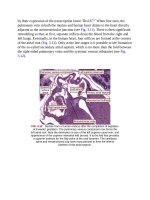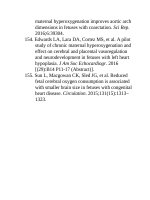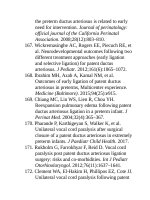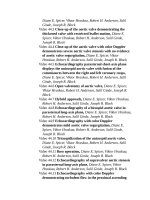Andersons pediatric cardiology 1118
Bạn đang xem bản rút gọn của tài liệu. Xem và tải ngay bản đầy đủ của tài liệu tại đây (130.21 KB, 3 trang )
branchesarebeingassessed,especiallyinrelationtosurroundingstructures,they
arelesshelpfulinassessmentofthepulmonaryvalve.However,future
technologicadvancesinthespeedofacquisitionofimages,ECGgating,and
postprocessingmayenhancetheutilityofMRIintheevaluationofisolated
pulmonaryvalvestenosis.Atpresent,however,itislikelythatmoreinformation
aboutthemorphologyofthepulmonaryvalvewillbeavailablewith
echocardiography(includingthree-dimensionalecho).
FIG.42.23 Three-dimensionalvolume-renderedreconstructionoftheright
ventricularoutflowtract(imagesacquiredwithcontrast-enhancedmagnetic
resonanceangiography).Notethenarrowingofthepulmonarytrunkand
grossdilationoftheleftpulmonaryartery.(CourtesyAndrewTaylor,
ConsultantCardiacRadiologist,GreatOrmondStreetHospitalforChildren,
London.)
CardiacCatheterizationandAngiography
Diagnosticcardiaccatheterizationhasbeenalmostcompletelysupersededby
lessinvasivetechniques,suchasechocardiography,fortheassessmentof
pulmonaryvalvestenosis,andisnowundertakenonlytoperformcatheter
interventionsorifadditionalassociatedanomalies(suchasbranchpulmonary
arterystenosis)warrantcardiaccatheterization.Theoneadvantageofcardiac
catheterizationoverotherimagingtechniquesistheaccuratemeasurementof
ventricularandpulmonaryarterialpressures.Itisimportanttorememberthatin
contrasttoDopplerechocardiography,whichestimatespeakinstantaneous
differencesinpressureacrossthestenosis(seeFig.42.19),gradientsobtainedin
thecatheterizationlaboratorythroughapullbacktechniqueshowapeak-to-peak
differenceinpressurebetweenthesitesofmeasurement,whichisusuallyupto
25%to40%lowerthanthepeakinstantaneousDopplergradient(Fig.42.24).
Importantlythough,hemodynamicevaluationalonedoesnotjustifyadiagnostic
cardiaccatheterizationunlessthepatientisconsideredforpossibleballoon
pulmonaryvalvuloplasty.
FIG.42.24 Peak-to-peakpullbackgradientmeasuredatcardiac
catheterization.
KeyDiagnosticFeatures
ThekeyfeaturesaresummarizedinBox42.1.
Box42.1
KeyDiagnosticFeaturesofPulmonaryValvar
Stenosis
PhysicalExamination
▪Physicalsignsofrightventricularhypertrophy
▪Systolicejectionclick(unlesssevere)
▪Ejectionsystolicmurmur,secondleftintercostalspaceandback
▪Widesplittingofthesecondheartsound(dependingonseverity)
▪ReducedintensityofP2(dependingonseverity)
▪Associatedthrill(dependingonseverity)
Investigations
▪Rightventricularhypertrophyonelectrocardiogram
▪Echocardiography
▪Thickenedanddomingvalve
▪Evidenceofturbulenceandflowaccelerationatpulmonaryvalve









